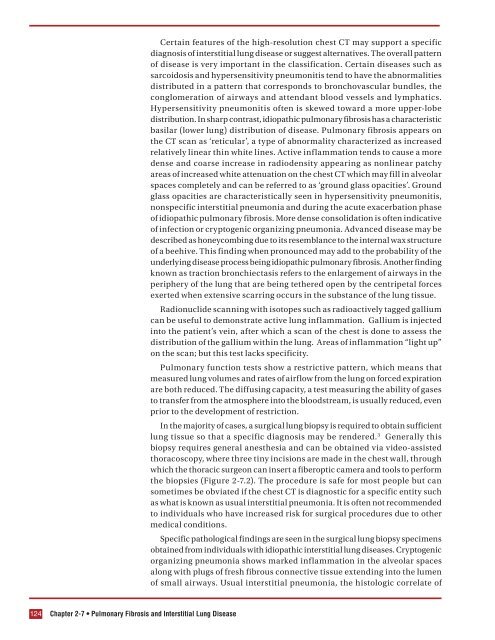Respiratory Diseases and the Fire Service
Create successful ePaper yourself
Turn your PDF publications into a flip-book with our unique Google optimized e-Paper software.
Certain features of <strong>the</strong> high-resolution chest CT may support a specific<br />
diagnosis of interstitial lung disease or suggest alternatives. The overall pattern<br />
of disease is very important in <strong>the</strong> classification. Certain diseases such as<br />
sarcoidosis <strong>and</strong> hypersensitivity pneumonitis tend to have <strong>the</strong> abnormalities<br />
distributed in a pattern that corresponds to bronchovascular bundles, <strong>the</strong><br />
conglomeration of airways <strong>and</strong> attendant blood vessels <strong>and</strong> lymphatics.<br />
Hypersensitivity pneumonitis often is skewed toward a more upper-lobe<br />
distribution. In sharp contrast, idiopathic pulmonary fibrosis has a characteristic<br />
basilar (lower lung) distribution of disease. Pulmonary fibrosis appears on<br />
<strong>the</strong> CT scan as ‘reticular’, a type of abnormality characterized as increased<br />
relatively linear thin white lines. Active inflammation tends to cause a more<br />
dense <strong>and</strong> coarse increase in radiodensity appearing as nonlinear patchy<br />
areas of increased white attenuation on <strong>the</strong> chest CT which may fill in alveolar<br />
spaces completely <strong>and</strong> can be referred to as ‘ground glass opacities’. Ground<br />
glass opacities are characteristically seen in hypersensitivity pneumonitis,<br />
nonspecific interstitial pneumonia <strong>and</strong> during <strong>the</strong> acute exacerbation phase<br />
of idiopathic pulmonary fibrosis. More dense consolidation is often indicative<br />
of infection or cryptogenic organizing pneumonia. Advanced disease may be<br />
described as honeycombing due to its resemblance to <strong>the</strong> internal wax structure<br />
of a beehive. This finding when pronounced may add to <strong>the</strong> probability of <strong>the</strong><br />
underlying disease process being idiopathic pulmonary fibrosis. Ano<strong>the</strong>r finding<br />
known as traction bronchiectasis refers to <strong>the</strong> enlargement of airways in <strong>the</strong><br />
periphery of <strong>the</strong> lung that are being te<strong>the</strong>red open by <strong>the</strong> centripetal forces<br />
exerted when extensive scarring occurs in <strong>the</strong> substance of <strong>the</strong> lung tissue.<br />
Radionuclide scanning with isotopes such as radioactively tagged gallium<br />
can be useful to demonstrate active lung inflammation. Gallium is injected<br />
into <strong>the</strong> patient’s vein, after which a scan of <strong>the</strong> chest is done to assess <strong>the</strong><br />
distribution of <strong>the</strong> gallium within <strong>the</strong> lung. Areas of inflammation “light up”<br />
on <strong>the</strong> scan; but this test lacks specificity.<br />
Pulmonary function tests show a restrictive pattern, which means that<br />
measured lung volumes <strong>and</strong> rates of airflow from <strong>the</strong> lung on forced expiration<br />
are both reduced. The diffusing capacity, a test measuring <strong>the</strong> ability of gases<br />
to transfer from <strong>the</strong> atmosphere into <strong>the</strong> bloodstream, is usually reduced, even<br />
prior to <strong>the</strong> development of restriction.<br />
In <strong>the</strong> majority of cases, a surgical lung biopsy is required to obtain sufficient<br />
lung tissue so that a specific diagnosis may be rendered. 3 Generally this<br />
biopsy requires general anes<strong>the</strong>sia <strong>and</strong> can be obtained via video-assisted<br />
thoracoscopy, where three tiny incisions are made in <strong>the</strong> chest wall, through<br />
which <strong>the</strong> thoracic surgeon can insert a fiberoptic camera <strong>and</strong> tools to perform<br />
<strong>the</strong> biopsies (Figure 2-7.2). The procedure is safe for most people but can<br />
sometimes be obviated if <strong>the</strong> chest CT is diagnostic for a specific entity such<br />
as what is known as usual interstitial pneumonia. It is often not recommended<br />
to individuals who have increased risk for surgical procedures due to o<strong>the</strong>r<br />
medical conditions.<br />
Specific pathological findings are seen in <strong>the</strong> surgical lung biopsy specimens<br />
obtained from individuals with idiopathic interstitial lung diseases. Cryptogenic<br />
organizing pneumonia shows marked inflammation in <strong>the</strong> alveolar spaces<br />
along with plugs of fresh fibrous connective tissue extending into <strong>the</strong> lumen<br />
of small airways. Usual interstitial pneumonia, <strong>the</strong> histologic correlate of<br />
124<br />
Chapter 2-7 • Pulmonary Fibrosis <strong>and</strong> Interstitial Lung Disease


